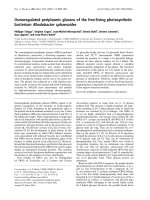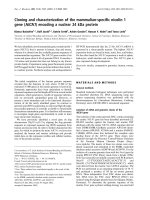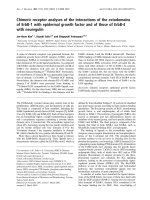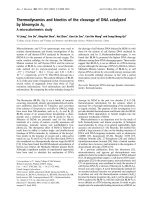Báo cáo y học: "Failed surgical ligation of the proximal left subclavian artery during hybrid thoracic endovascular aortic repair successfully managed by percutaneous plug or coil occlusion: a report of 3 cases" ppsx
Bạn đang xem bản rút gọn của tài liệu. Xem và tải ngay bản đầy đủ của tài liệu tại đây (5.01 MB, 6 trang )
CAS E REP O R T Open Access
Failed surgical ligation of the proximal left
subclavian artery during hybrid thoracic
endovascular aortic repair successfully managed
by percutaneous plug or coil occlusion:
a report of 3 cases
Geert Maleux
*
, Johan Vaninbroukx and Sam Heye
Abstract
Open surgical rerouting and proximal ligation of one or more supra-aortic vessels prior to endovascular stent-graft
placement has become an alternative to major open thoracic surgery in the treatment of complex thoracic aortic
disease. Complications owing to failed surgical ligation of the left subclavian artery are rare. In this report, 3 cases
of failed ligation are presented. Diagnosis was made by CT-scan and treatment was performed by transcatheter
coil and plug embolization, avoiding redo neck surgery.
Background
Endovascular repair has become a valuable alternative to
open repair for the treatment of several thoracic aortic
pathologies [1-4]. However, stent-graft placement
requires an adequate proximal and distal landing zone
in the aorta of at least 2 cm in order to avoid early or
late type I endoleak. Therefore, surgical ligation and
rerouting of one or more supra-aortic vessels can be
necessary for safe stent-graft deployment and efficient
and durable clinical outcome. Recent reports deal with
the successful technical and clinical outcome after
supra-aortic rerouting [5-7]. However, type and manage-
ment of complications related to t his type of open vas-
cular surgery are scarce and not well-documented [7].
In this report we present the clinical and radiological
outcome after endovascular management of failed surgi-
cal ligation of the left subclavian artery during supra-
aortic rerouting for safe thoracic stent-graft placement.
From 1999 to end of 2009, 172 thoracic stent-graft
procedures in 160 patients were performed in the
author’s institution. In 49 patients (30%), supra-aortic
rerouting was performed. In 41 out of these 49 patients
(84%) perioperative surgical ligation of the left
subclavian artery was performed in association with
supra-aortic rerouting. All patients were followed up
according to the EUROST AR guidelines [8]. In 3 out of
these 41 patients (7%) previously treated by left subcla-
vian artery ligation, persistent flo w through the ligated
artery was identified and associated with gradual
increase of aneurismal or false luminal diameter. There
were no patients with persistent retrograde flow through
the prevertebral left subclavian artery, but with a stable
or decreasing aneurismal sac.
Case Presentation
Case 1
A 65-year-old man presented with persistent thoracic
pain since two weeks. Serial computed tomography (CT)
scans reveal ed an aortic dissection, Stanfo rd type II
starting at the origin of the left subclavian artery (Figure
1) and with progressive increase of thoracic aortic dia-
meter up to 5 cm over a two week time period. A deci-
sion was taken to exclude the aneurismal false l umen
with use of a stent-g raft (Talent, Medtronic, Santa Rosa,
CA, USA). Becaus e of unintentional covering of the ori-
gin of the left common carotid artery, a carotidocarotid
bypass was performed, but despite many intraoperative
efforts, it was not possible to ligate the proximal left
* Correspondence:
Department of Radiology, University Hospitals Leuven, Belgium
Maleux et al. Journal of Cardiothoracic Surgery 2011, 6:45
/>© 2011 Maleux et al; licensee BioMed Central Ltd. This is an Open Access article distributed under the terms of the Creative Commons
Attribution License (http://creativecom mons.org/licenses/by/2.0), w hich permits unrestricted use, distribution, and reproduction in
any medium, provided the original work is properly cited.
subclavian artery via the cervicotomy. The patient recov-
ered well without neurological sequellae and the thor-
acic pain disappeared progressively. Control physical
examination at 3, 6 and 12 months after the thoracic
endovascular aortic repair (TEVAR) was uneventful
except for a persistent left radial pulse. CT-scans
revealed a persistent opacification of the false lumen
and the entire left subclavian artery (Figure 2). A dis-
creteincreaseinthoracicaorticdiameterupto59mm
was noted. Catheter angiography performed 13 months
after initial EVAR showed a fully patent stent-graft and
retrograde opacification of the false lumen through con-
nections between true and false aortic lumen at the level
of the thoraco-abdominal and abdominal aorta; no sub-
clavian steal phenomenon was identified (Figure 3a-b).
After puncturing the left brachial artery and cannulation
of the proximal subclavian artery and false lumen, selec-
tive angiography revealed antegrade opacification of the
left subclavian and vertebral artery: the left upper limb
and left posterior circulation was feeded antegradely via
the retrogradely perfused false aortic l umen. It was
decided to occlude the prevertebral segment of the left
subclavian artery using a 16 mm diameter vascular plug
(Amplatzer plug, AGA Medical, Plymouth, MN, USA).
Completion angiography after plug placement revealed a
suclavian steal via retrograde opacification of the left
vertebral artery and antegrade opacification of the sub-
clavian artery with exception of the completely throm-
bosed prevertebral segment (Figure 4a-b). Clinically,
there was no more radial pulse palpable and symptoms
of left arm claudication were noted, but these w ere
managed conservatively.
Control CT-scan one year later showed a progressive
increase in diameter of the distal thoracic aorta below
the stent-graft. An extension stent-graft (Talent, Med-
tronic, USA) was successfully placed landing at the
tenth thoracic vertebra. The patient was discharged 3
days later. CT-scan at 1, 2 and 3 years follow-up after
placement of the extention stent-graft revealed complete
thrombosis of the false lumen and occlusio n of the left
subclavian artery with the occlusion-plug in place. The
diameter of the thoracic aorta remained stable with a
maximum diameter of 50 mm (Figure 5).
Case 2
A 78-year-old man presented with an asymptomatic
aneurysm of the proximal descending thoracic aorta
with a maximal diameter of 66 mm. The patient already
underwent endovascular exclusion of an abdominal aor-
tic aneurysm two years earlier. It was decided to exclude
the thoracic aneurysm with use of a stent-graft (Valiant,
Medtronic, Santa Clara, CA, USA) after placing a caroti-
dosubclavian bypass and ligation of the proximal left
subclavian artery in order to minimize potential post-
operative neurological symptoms related to myelum
ischemia. The postoperative period was uneventful
except for fever up to 38°C for 3 days; no signs of arm
claudication were noted. Control CT-scan 6 months
later revealed discrete increase of the aneurismal sac
diameter up to 69 mm owing to a type II endoleak by
retrograde sac perfusion through the incompletely
ligat ed proximal left s ubclav ian artery. It was decided to
treat the endoleak. Under local anesthesia, the left bra-
chial artery was punctured and a 45 cm long 8 F sheath
(Arrows, Reading, PE, USA) was i nserted. Angiography
rev ealed the retrograde opacification of the prevertebral
segment of the left subclav ian artery, resulting in a type
Figure 1 Thoracic aortic CT-scan at admission reveals a classic
Stanford type B aortic dissection without clear false lumen
dilatation.
Figure 2 Coronal CT-reconstruction image one year after stent-
grafting shows persistent opacification of both the left
subclavian artery (white arrow) and the false thoracic aortic
lumen (black asterisk).
Maleux et al. Journal of Cardiothoracic Surgery 2011, 6:45
/>Page 2 of 6
II endoleak. A 16 mm nominal diameter vascular plug
(Amplatzer vascular plug, AGA Medical, Plymouth, MN,
USA)wasplacedattheoriginoftheleftsubclavian
artery, with complete disappearence of the endoleak.
Control CT-scan at one and two years follow-up
revealed absence of any residual type II endoleak and
stable diameter of the thoracic aneurysm up to 68 mm.
Case 3
A 68-year-old man presented with an asymptomatic,
focal atherosclerotic aneurysm of the aortic arch (maxi-
mal diameter of 6 cm) and another, focal, thoraco-
abdominal aneurysm with a diameter of 5.5 cm, ending
at the level of the origin of the renal arteries. Eleven
years ago, the patient also underwent an elective surgical
repair for an infrarenal abdominal aortic aneurysm. It
was decided to first treat the arch aneurysm with use of
a hybrid vascular procedure: A carotid-carotid bypass
with additional bypass to the left subclavian artery was
performed using a Silver 8 mm vascular graft; concomi-
tantly a surgical ligation of the left subclavian artery
proximal to the origin of the left vertebral artery was
performed. Afterwards a stent-graft (TAG, W.L. Gore &
Associates, Flagstaff, AZ, USA) starting at the origin of
the brachiocephalic trunk and ending in the descending
thoracic aorta, was inserted and resulting in a complete
Figure 3 Catheter angiography of the aortic arch. ( a) Catheter angiography of the aort ic arch, 13 months after hybrid surgery shows the
stent-graft in place, starting just distal to the origin of the brachiocephalic trunk. Note also the good patency of the carotido-carotid bypass.
There is no opacification of the left subclavian artery. (b) After puncturing the left brachial artery, a calibrated pigtail is navigated through the
proximal left subclavian artery (arrows) into the false lumen of the thoracic aorta (arrowheads). Note the antegrade flow in the left subclavian
artery.
Figure 4 Angiography after Amplatzer-plug deploymen t. (a) Selective injection of contrast medium in the distal left subclavian artery after
Amplatzer-plug deployment (arrow) demonstrates a total occlusion of the proximal left subclavian artery. (b) Flush aortography after Amplatzer-
plug deployment (arrows) reveals retrograde opacification (subclavian steal phenomenon) of the left subclavian artery through the retrogradely
filling left vertebral artery.
Maleux et al. Journal of Cardiothoracic Surgery 2011, 6:45
/>Page 3 of 6
exclusion of the aneurysm. Postoperative follow-up was
uneventful and three months later, patient underwent a
Crawford operation for his thoraco-abdominal aneurysm
with reimplantation of all visceral arteries including
celiac trunk, superior mesenteric artery and both renal
arteries. Six months later, follow-up CT-scan revealed a
growing thoracic arch aneurysm and a type II endoleak
by retrograde perfusion of the aneurysmal sac through
an i ncompletely ligated left subclavian artery (Figure 6).
It was decided to treat the type II endoleak by trans-
catheter technique. After local anesthesia, the left
brachial artery was punctured and a 4F sheath was
introduced. Through a 4F Cobra-catheter (Cook Medi-
cal, Bloomington IN, USA) a microcatheter (Miraflex,
Cook Medical, Bloomington IN, USA) was navigated
with the tip in the proximal left subclavian artery.
Deployment of 3 fibered microcoils (Target Therapeu-
tics, Boston Scientific Corporation, Natick, MA, USA)
completely occluded the origin of the left subclavian
artery with disappearance of the endoleak (Figure 7a-b).
Control CT-scan 9 months later revealed a completely
excluded thoracic aortic aneurysm without endoleak and
stable in diameter.
Discussion
Combined open and endovascular surgical repair is
recently propagated as a less invasive treatment option
for the management of aortic arch pathologies like
aneurysms, dissections or penetrating ulcers [1,7,9-12].
However, these operations are also not free of early or
late complications: myocardial infarction, respiratory
and renal failure, postoperative hematoma, vertebrobasi-
lar insufficiency or stroke are potential complications
[13-18]. In this study we report on a yet unreported, not
very uncommon (7% of all supraaortic rerouting cases
with ligation), but silent complication after supra-aortic
rerouting, namely an incomplete ligation of the left sub-
clavian artery resulting in persistent perfusion of the
thoracic aneurysm in two cases and in persistent, retro-
grade perfusion of the false lumen in the remaining
case. Additionally, in all cases these radiological findings
were associated with a gradual growth of the aneurismal
sac or false lumen, stressing the importance of this
silent complication. Adequate treatment seems to be
mandatory to avoid potential late rupture. In the pre-
sented cases, a surgical attempt was made to ligate the
prevertebral segment of the left subclavian artery; how-
ever, owing to surgical difficulties to clearly visualize
and mani pulate the deeply located proximal left subcla-
vian artery, the ligation was incomplete in two cases and
impossible in the remaining case. It is also understand-
able that a redo operation in these cases is even more
hazardous and by consequence, a minimally invasive
alternative treatment is preferred. Persistent flow
through the left subclavian artery was identified in all
three cases by contrast-enhanced CT-scan, underlining
the value of regular follow-up CT-scan after endovascu-
lar repair of aortic pathologies. In all three cases the
proximal left subclavian artery was approached by punc-
ture of the left brachial artery; the decision to oc clude
with coils [19 -21] or plug [13,22-25] depended on the
diameter of the prevertebral subclavian artery segment:
if the segment was large enough for a plug (n = 2), then
a plug was preferred owing to the ease of plug deploy-
ment; in t he remaining case the prevertebral segment
Figure 5 Co ntrol CT-scan 3 years after stent-graf t extension
shows a stable thoracic aortic diameter of 50 mm without
contrast opacification of the excluded false lumen, both in the
early arterial and in the late venous phase.
Figure 6 Coronal CT-reconstruction image 6 months after
stent-grafting reveals a faint opacification (white arrow) of the
proximal left subclavian artery with focal opacification of the
aneurismal sac lumen.
Maleux et al. Journal of Cardiothoracic Surgery 2011, 6:45
/>Page 4 of 6
was too small for safe plug-deployment and microcoils
were placed through a microcatheter. Except for a punc-
ture site hematoma, no complications occurred during
or after the procedure and in all cases no mo re perfu-
sion of the occluded vessel was indentified on sequential
follow-up CT-scan. The endovascular occlusion of the
proximal left subclavian artery has been successfully
performed in cases of intentional left subclavian artery
coverage by the endograft, without previous carotid-
subclavian transposition [ 13,19,20,22-25], using the
same endovascular techniques. Finally, the gradual
growth of the aneurismal sac or false lumen was
stopped after the occlusion procedure.
Conclusions
In summary, three cases of persistent flow through the
left subclavian artery after combined open en endovas-
cular surgery for thoracic aortic disease are presented.
CT-scan clearly identified the persistent left subclavian
artery opacification, despite previous surgical attempt of
ligation; catheter-angiography confirmed these findings.
Definitive occlusion of the prevertebral part of the left
subclavian artery can be performed using plug or coil s,
resulting in disappeara nce of the endoleak and in cessa-
tion of the aneurismal or false lumen growth.
Consent
In our institution no approval of the Ethical Committee
is required for case reports.
Authors’ contributions
GM has taken care of the concept, design and the acquisition of data. SH as
well as JV have taken care of the acquisition of data, the revision of the
manuscript, and the final approval for the manuscript to be published. All
contributing authors have read and approved the final manuscript.
Competing interests
The authors declare that they have no competing interests.
Received: 17 December 2010 Accepted: 8 April 2011
Published: 8 April 2011
References
1. Gaxotte V, Thony F, Rousseau H, Lions C, Otal P, Willeteaux S, Rodiere M,
Negaiwi Z, Joffre F, Beregi JP: Midterm results of aortic diameter
outcomes after thoracic stent-graft implantation for aortic dissection: A
multicenter study. J Endovasc Ther 2006, 13:127-138.
2. Garzon G, Fernandez-Velilla M, Marti M, Acitores I, Ybanez F, Riera L:
Endovascular stent-graft treatment of thoracic aortic disease.
Radiographics 2005, 25:229-244.
3. Fernandez V, Mestres G, Maeso J, Domínguez JM, Aloy MC, Matas M:
Endovascular treatment of traumatic thoracic aortic injuries: short- and
medium-term follow-up. Ann Vasc Surg 2010, 24(2):160-166.
4. Rousseau H, Bolduc JP, Dambrin C, Marcheix B, Canevet G, Otal P: Stent-
graft repair of thoracic aortic aneurysms. Tech Vasc Interv Radiol 2005,
8(1):61-72.
5. Gottardi R, Funovics M, Eggers N, Hirner A, Dorfmeister M, Holfeld J,
Zimpfer D, Schoder M, Donas K, Weigang E, Lammer J, Grimm M, Czerny M:
Supra-aortic transposition for combined vascular and endovascular
repair of aortic arch pathology. Ann Thor Surg 2008, 86:1524-1529.
6. Czerny M, Gottardi R, Zimpfer D, Schoder M, Grabenwoger M, Lammer J,
Wolner E, Grimm M: Mid-term results of supra-aortic transpositions for
extended endovascular repair of aortic arch pathologies. Eur J
Cardiothorac Surg 2007, 31:623-627.
7. Younes HK, Davies MG, Bismuth J, Naoum JJ, Peden EK, Reardon MJ,
Lumsden AB: Hybrid thoracic endovascular aortic repair: pushing the
envelope. J Vasc Surg 2010, 51(1):259-266.
8. Leurs LJ, Bell R, Degrieck Y, Thomas S, Hobo R, Lundbom J, EUROSTAR; UK
Thoracic Endograft Registry collaborators: Endovascular treatment of
thoracic aortic diseases: combined experience from the EUROSTAR and
United Kingdom Thoracic Endograft registries. J Vasc Surg 2004,
40(4):670-679, discussion 679-680
9. Kusagawa H, Shimonon T, Ishida M, Suzuki T, Yasuda F, Yuasa U, Onoda K,
Yada I, Hirano T, Takeda K, Kato N: Changes in false lumen after
transluminal stent-graft placement in aortic dissections: six years’
experience. Circulation 2005, 111:2951-2957.
10. Schoder M, Czerny M, Cejna M, Rand T, Stadler A, Sodeck GH, Gottardi R,
Loewe C, Lammer J: Endovascular repair of acute type B aortic
dissection: long-term follow-up of true and false lumen diameter
changes. Ann Thor Surg 2007, 83:1059-1066.
11. Lopera J, Patino JH, Urbina C, Garcia G, Alvarez LG, Upegui L, Jhanchai A,
Qian Z, Castaneda-Zuniga W: Endovascular treatment of complicated
Figure 7 Catheter angiography of the left subclavian artery.(a)Selectiveinjectionoftheleftsubclavian artery through a brachial artery
catheter shows a well-functioning carotido-subclavian bypass and faint retrograde opacification of the proximal left subclavian artery and
aneurismal sac (arrow), suggesting a type II endoleak. (b) After coil embolisation (arrowhead), there is no more opacification of both the proximal
left subclavian artery and the small type II endoleak.
Maleux et al. Journal of Cardiothoracic Surgery 2011, 6:45
/>Page 5 of 6
type-B aortic dissection with stent-grafts: Midterm results. J Vasc Interv
Radiol 2003, 14:195-203.
12. Czerny M, Zimpfer D, Rodler S, Funovics M, Dorfmeister M, Schoder M,
Marta G, Weigang E, Gottardi R, Lammer J, Wolner E, Grimm M:
Endovascular stent-graft placement of aneurysms involving the
descending aorta originating from chronic type B dissections. Ann Thor
Surg 2007, 83:1635-1639.
13. Chaudhuri A, Tibballs J, Nadkarni S, Garbowski M: Digital embolization due
to partially uncovered left subclavian artery post Tevar: Management
with Amplatzer vascular plug occlusion. J Endovasc Ther 2007,
14:1545-1550.
14. Peterson BG, Eskandari MK, Gleason TG, Morasch MD: Utility of left
subclavian artery revascularisation in association with endoluminal
repair of acute and chronic thoracic aortic pathology. J Vasc Surg 2006,
43:433-439.
15. Weigang E, Luehr M, Harloff A, Euringer W, Etz CD, Szabo G, Beyersdorf F,
Siegenthaler MP: Incidence of neurological complications following
overstenting of the left subclavian artery. Eur J CardioThor Surg 2007,
31:628-636.
16. Riesenman PJ, Farber MA, Mendes RR, Marston WA, Fulton JJ, Keagy BA:
Coverage of the left subclavian artery during thoracic endovascular
aortic repair. J Vasc Surg 2007, 45:90-95.
17. Rehders TC, Petzsch M, Ince H, Kische S, Kôrber T, Koschyk DH, Chatterjee T,
Weber F, Nienaber CA: Intentional occlusion of the left subclavian artery
during stent-graft implantation in the thoracic aorta: risk and relevance.
J Endovasc Ther 2004, 11:659-666.
18. Messé SR, Bavaria JE, Mullen M, Cheung AT, Davis R, Augoustides JG,
Gutsche J, Woo EY, Szeto WY, Pochettino A, Woo YJ, Kasner SE,
McGarvey M: Neurologic outcomes from high risk descending thoracic
and thoracoabdominal aortic operations in the era of endovascular
repair. Neurocrit Care 2008, 9(3):344-351.
19. Lacroix V, Astarci P, Devaux P, Goffette P, Hammer F, Verhelst R,
Noirhomme P: Endovascular treatment of an aneurysmal aberrant right
subclavian artery. J Endovasc Ther 2003, 10:190-194.
20. Peterson MD, Wheatley GH, Kpodonu J, Williams JP, Ramaiah VG,
Rodriguez-Lopez JA, Dietrich EB: Treatment of type II endoleaks
associated with left subclavian artery coverage during thoracic aortic
stent grafting. J Thorac Cardiovasc Surg 2008, 136:1193-1199.
21. Rabellino M, Nielsen LG, Baldi S, Zander T, Arnaiz L, Llorens R, Zerolo I,
Maynar M: Retrograde embolization of the left vertebral artery in a type
II endoleak after endovascular treatment of aortic thoracic rupture:
technical note. Cardiovasc Intervent Radiol 2009, 32:169-173.
22. Kato N, Semba CP, Dake MD: Use of a self-expanding vascular occluder
for embolization during endovascular aortic aneurysm repair. J Vasc
Interv Radiol 1997, 8:27-33.
23. Hoppe H, Hohenwalter EJ, Kaufman JA, Petersen B: Percutaneous
treatment of aberrant right subclavian artery aneurysm with use of the
Amplatzer septal occluder. J Vasc Interv Radiol 2006, 17:889-894.
24. Ferro C, Petrocelli F, Rossi UG, Bovio G, Dahmane M’
H, Seitun S: Vascular
percutaneous transcatheter embolization with a new device: Amplatzer
vascular plug. Radiol Med 2007, 112:239-251.
25. Meyer C, Probst C, Strunk H, Schiller W, Wilhelm K: Second-generation
Amplatzer vascular plug (AVP) for the treatment of subsequent
subclavian backflow type II endoleak after TEVAR. CardioVasc Intervent
Radiol 2009, 32:1264-1267.
doi:10.1186/1749-8090-6-45
Cite this article as: Maleux et al.: Failed surgical ligation of the proximal
left subclavian artery during hybrid thoracic endovascular aortic repair
successfully managed by percutaneous plug or coil occlusion: a report
of 3 cases. Journal of Cardiothoracic Surgery 2011 6:45.
Submit your next manuscript to BioMed Central
and take full advantage of:
• Convenient online submission
• Thorough peer review
• No space constraints or color figure charges
• Immediate publication on acceptance
• Inclusion in PubMed, CAS, Scopus and Google Scholar
• Research which is freely available for redistribution
Submit your manuscript at
www.biomedcentral.com/submit
Maleux et al. Journal of Cardiothoracic Surgery 2011, 6:45
/>Page 6 of 6









